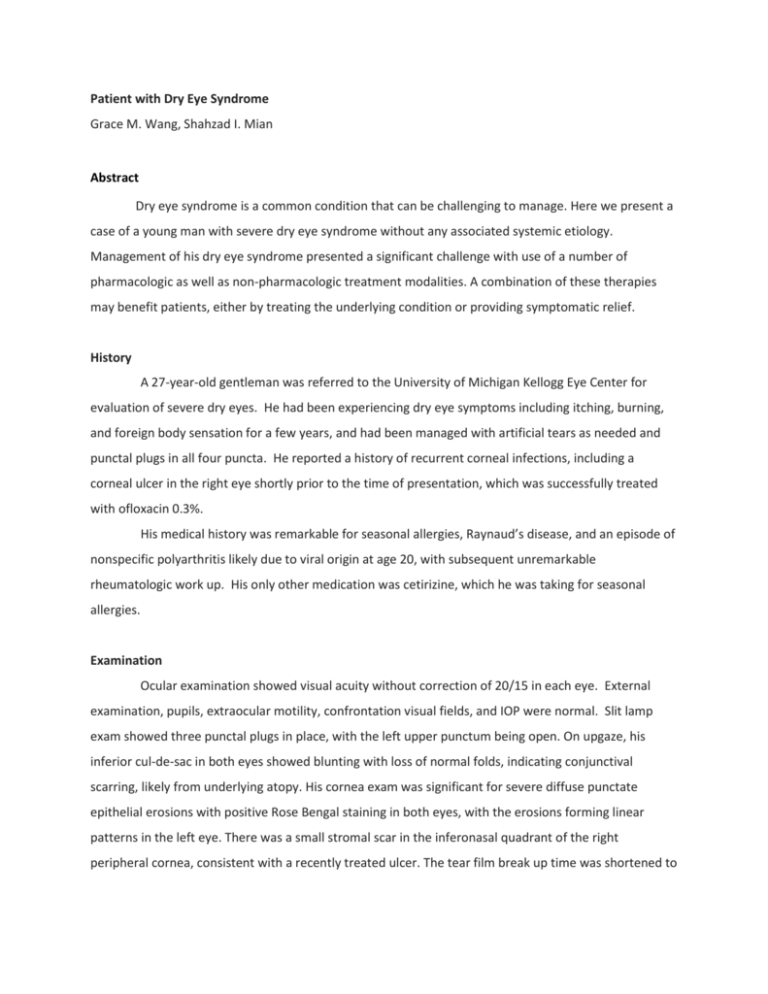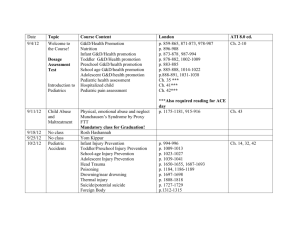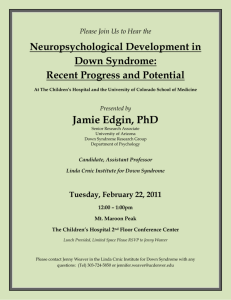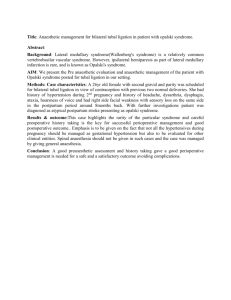Patient with Dry Eye Syndrome Grace M. Wang, Shahzad I. Mian
advertisement

Patient with Dry Eye Syndrome Grace M. Wang, Shahzad I. Mian Abstract Dry eye syndrome is a common condition that can be challenging to manage. Here we present a case of a young man with severe dry eye syndrome without any associated systemic etiology. Management of his dry eye syndrome presented a significant challenge with use of a number of pharmacologic as well as non-pharmacologic treatment modalities. A combination of these therapies may benefit patients, either by treating the underlying condition or providing symptomatic relief. History A 27-year-old gentleman was referred to the University of Michigan Kellogg Eye Center for evaluation of severe dry eyes. He had been experiencing dry eye symptoms including itching, burning, and foreign body sensation for a few years, and had been managed with artificial tears as needed and punctal plugs in all four puncta. He reported a history of recurrent corneal infections, including a corneal ulcer in the right eye shortly prior to the time of presentation, which was successfully treated with ofloxacin 0.3%. His medical history was remarkable for seasonal allergies, Raynaud’s disease, and an episode of nonspecific polyarthritis likely due to viral origin at age 20, with subsequent unremarkable rheumatologic work up. His only other medication was cetirizine, which he was taking for seasonal allergies. Examination Ocular examination showed visual acuity without correction of 20/15 in each eye. External examination, pupils, extraocular motility, confrontation visual fields, and IOP were normal. Slit lamp exam showed three punctal plugs in place, with the left upper punctum being open. On upgaze, his inferior cul-de-sac in both eyes showed blunting with loss of normal folds, indicating conjunctival scarring, likely from underlying atopy. His cornea exam was significant for severe diffuse punctate epithelial erosions with positive Rose Bengal staining in both eyes, with the erosions forming linear patterns in the left eye. There was a small stromal scar in the inferonasal quadrant of the right peripheral cornea, consistent with a recently treated ulcer. The tear film break up time was shortened to 3 seconds in both eyes. Schirmer test with the use of topical anesthetic revealed 0mm of wetting in both eyes after 5 minutes. The rest of his anterior segment exam as well as fundus exam were normal. Discussion and diagnosis Dry eye syndrome is a common problem with varying severities of clinical presentation. In patients with more severe disease, it can be symptomatically debilitating and difficult to manage. Poor protection of the ocular surface can affect visual acuity, or predispose patients to other disease processes such as corneal ulcers, as evident in this patient. Complete evaluation of dry eye syndrome includes a detailed review of systems in addition to a thorough ophthalmic examination. A number of underlying ocular and systemic conditions can cause dry eye disease. Common etiologies may include anatomic variation, poor tear production, and inflammatory conditions. In this patient, history of atopy and the use of cetirizine were thought to contribute to the reduction of his tear production. Subsequently, he underwent repeat rheumatologic evaluation, which was negative for RF, HLA-B27, ESR, except a nonspecific finding of positive ANA. Treatment of primary dry eye syndrome is focused on addressing aqueous tear deficiency and increased tear evaporation. Lubricants including artificial tears, gels, and ointments are typically first line. These agents provide symptomatic relief as well as ocular surface protection. For those with more severe disease associated with conjunctival injury, topical cyclosporine A 0.05% has been shown to effectively reduce symptoms as well as improve objective measurements of dry eye disease including TBUT (tear break up time), Schirmer test, and OSDI (ocular surface disease index) in some patients [1-3]. Autologous serum (AS) tears have become an increasingly popular second line treatment for dry eye syndrome. AS biochemical contents include immunoglobulins, vitamin A, fibronectin, and growth factors that promote epithelial healthy by mimicking natural tears more closely than artificial tears. Studies have illustrated better symptomatic relief with the use of AS tears, and some recent clinical trials have shown greater objective improvement in TBUT and OSDI compared to artificial tears alone[4-6]. Other pharmacologic treatment in dry eye syndrome target underlying conditions that contribute to dry eyes. Short courses of mild topical steroid can be helpful particularly in patients with conjunctival inflammation, which can aggravate dry eye symptoms. In patients with comorbidities of blepharitis or ocular rosacea, which lead to increased tear film evaporation and contribute to dry eye symptoms, oral doxycycline or azithromycin can be used to treat the underlying cause and improve dry eye symptoms. For blepharitis associated with ocular demodecosis, tea tree oil has been found to be effective [7, 8]. For patients with dry eye symptoms associated with systemic inflammatory conditions, systemic anti-inflammatory treatments such as oral steroids can be considered, especially during a flare episode of the condition. In patients with Sjögren’s syndrome, oral pilocarpine has also been found to improve symptoms [9-11]. Additional non-pharmacologic treatments are also available to aid the management of dry eye syndrome. Punctal occlusion, which reduces the rate of tear drainage, can be achieved by plugs or thermal cautery. Warm compresses, lid scrub, and LipiFlow thermal pulsation can provide relief for patients whose dry eye symptoms are complicated by blepharitis and Meibomian gland dysfunction. For patients who fail combinations of the above pharmacologic treatments, scleral lenses, such as PROSE, or “prosthetic replacement of the ocular surface ecosystem”, can be used as well [8]. Our patient was initially managed with a short course of topical fluorometholone 0.1% to reduce ocular inflammation. In addition, left upper punctal plug was replaced, and he was initiated on cyclosporine 0.05% drops. He did well for several years with some improvement and was followed locally. On a subsequent return visit, he continued to have dry eye symptoms though his corneal surface on exam was much improved. He later underwent punctal cauterization after punctal plugs were repeatedly lost. He also tried AS tears as well as LipiFlow thermal pulsation without much additional relief of symptoms. The patient elected to be treated with PROSE, which he found helpful. At the most recent visit, his corneal surface was excellent and his Schirmer test with the use of topical anesthetic improved to 3mm and 4mm in the right and left eye. However, he continued to have lid irritation and dry sensation. He was initiated on topical tea tree oil wipes. Conclusion This case illustrates the multi-faceted problem of dry eye syndrome and the plethora of treatment options. In treating patients with this chronic condition, an ophthalmologist has many choices in both pharmacologic and non-pharmacologic treatments to help the patient. Identification of underlying causes of dry eye is important in selecting the appropriate treatments. References 1. 2. Deveci, H. and S. Kobak, The efficacy of topical 0.05 % cyclosporine A in patients with dry eye disease associated with Sjogren's syndrome. Int Ophthalmol, 2014. Yuksel, B., et al., Evaluation of the effect of topical cyclosporine A with impression cytology in dry eye patients. Eur J Ophthalmol, 2010. 20(4): p. 675-9. 3. 4. 5. 6. 7. 8. 9. 10. 11. Zhou, X.Q. and R.L. Wei, Topical Cyclosporine A in the Treatment of Dry Eye: A Systematic Review and Meta-analysis. Cornea, 2014. 33(7): p. 760-7. Celebi, A.R., C. Ulusoy, and G.E. Mirza, The efficacy of autologous serum eye drops for severe dry eye syndrome: a randomized double-blind crossover study. Graefes Arch Clin Exp Ophthalmol, 2014. 252(4): p. 619-26. Urzua, C.A., et al., Randomized double-blind clinical trial of autologous serum versus artificial tears in dry eye syndrome. Curr Eye Res, 2012. 37(8): p. 684-8. Pan, Q., et al., Autologous serum eye drops for dry eye. Cochrane Database Syst Rev, 2013. 8: p. CD009327. Hom, M.M., K.M. Mastrota, and S.E. Schachter, Demodex. Optom Vis Sci, 2013. 90(7): p. e198205. Gao, Y.Y., et al., Clinical treatment of ocular demodecosis by lid scrub with tea tree oil. Cornea, 2007. 26(2): p. 136-43. Tsifetaki, N., et al., Oral pilocarpine for the treatment of ocular symptoms in patients with Sjogren's syndrome: a randomised 12 week controlled study. Ann Rheum Dis, 2003. 62(12): p. 1204-7. Aragona, P., et al., Conjunctival epithelium improvement after systemic pilocarpine in patients with Sjogren's syndrome. Br J Ophthalmol, 2006. 90(2): p. 166-70. Papas, A.S., et al., Successful Treatment of Dry Mouth and Dry Eye Symptoms in Sjogren's Syndrome Patients With Oral Pilocarpine: A Randomized, Placebo-Controlled, Dose-Adjustment Study. J Clin Rheumatol, 2004. 10(4): p. 169-77.






